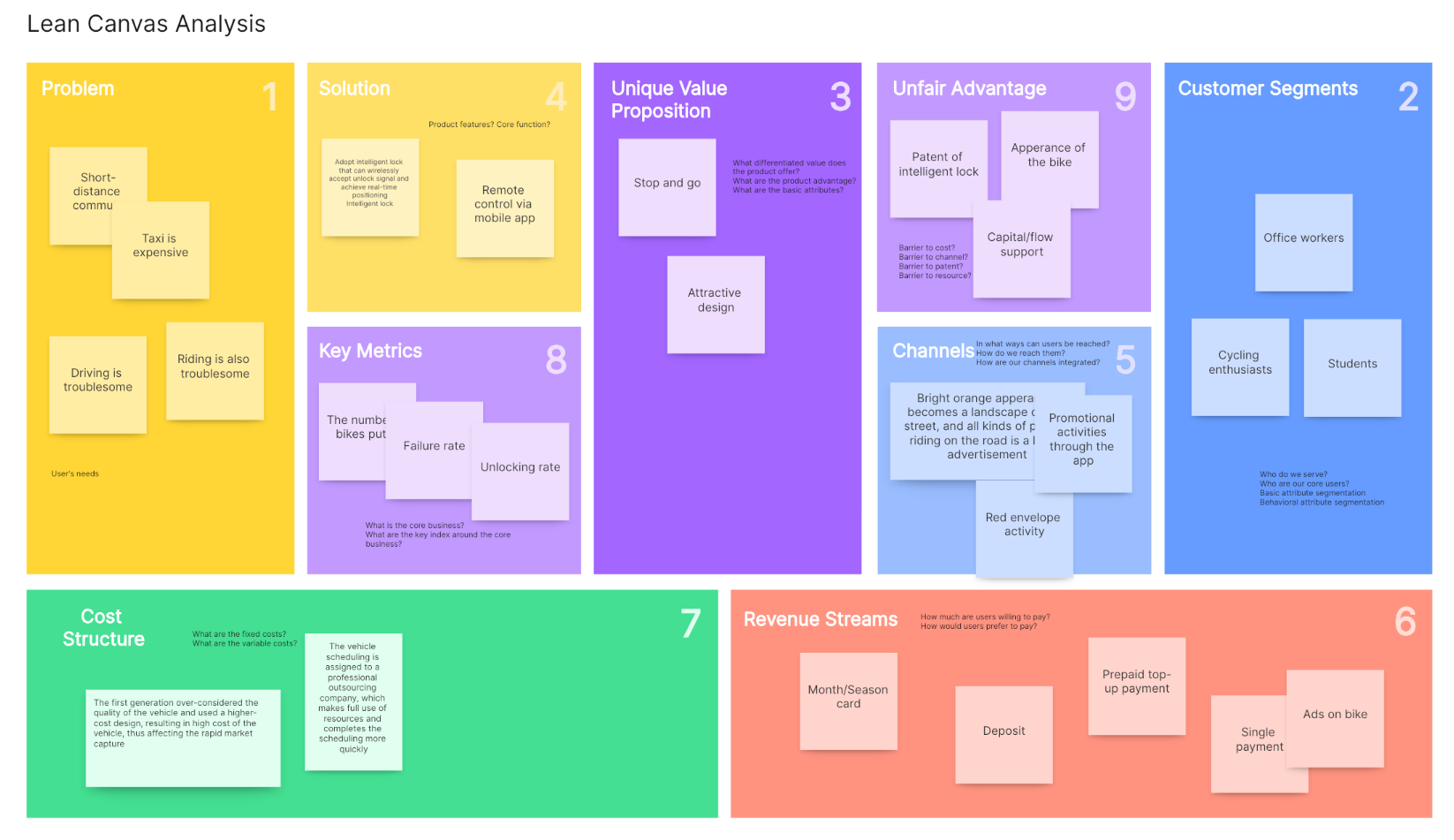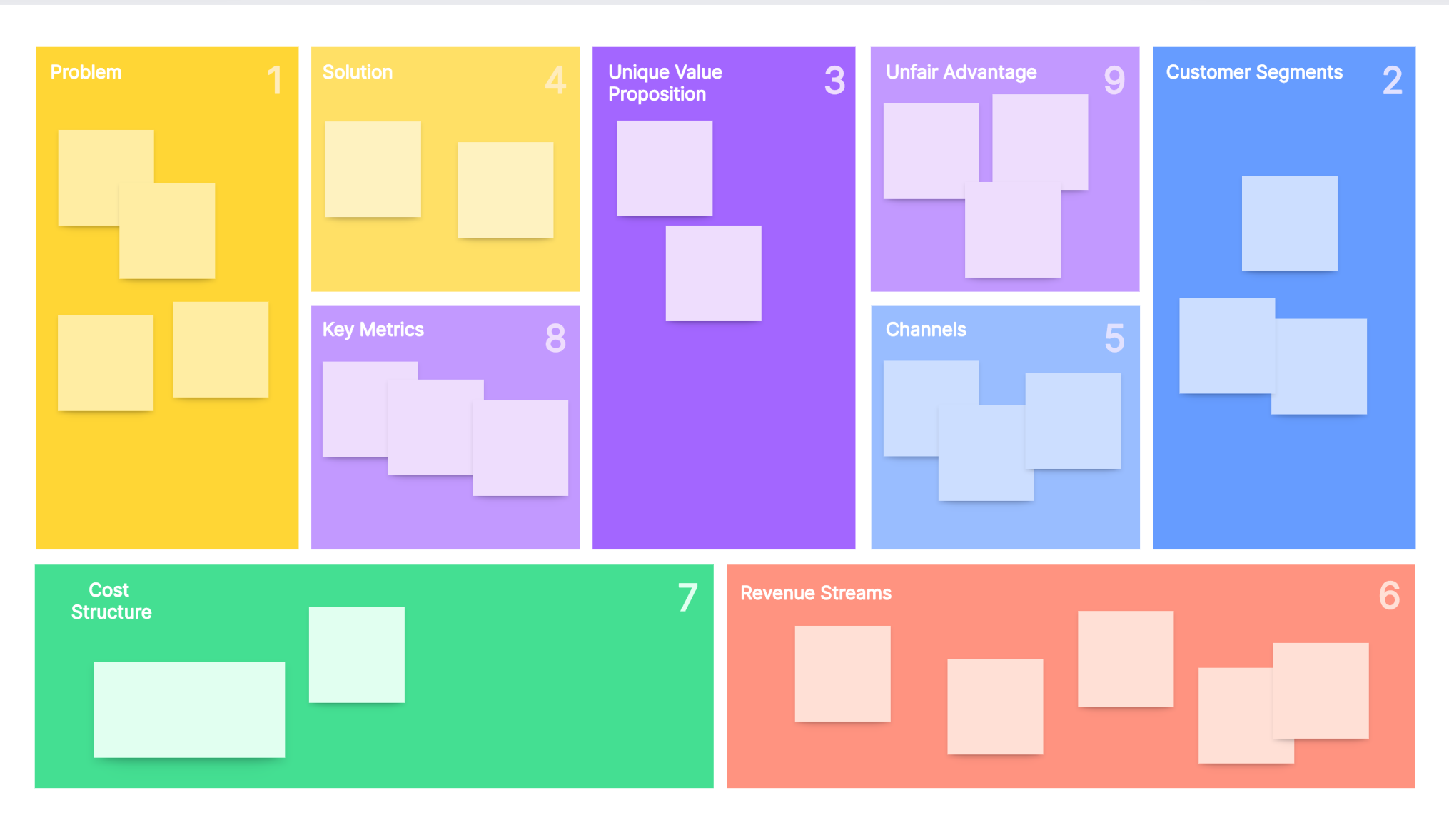Lean Canvas is a strategic blueprint that has significantly redefined the methodology of entrepreneurs and businesses in orchestrating their venture planning. This all-encompassing guide will illuminate the concept of Lean Canvas, its cardinal elements, its profound importance, and the optimal timing for its deployment. Dive into this revolutionary blueprint for concise, effective business planning, ensuring adaptability in a dynamic market. Master Lean Canvas principles for a competitive edge in today's business landscape.
Part 1. What is the concept of Lean Canvas?
Lean Canvas is a concise and visual one-page business plan that serves as a strategic framework for startups and entrepreneurs. It encapsulates key elements of a business model, such as customer segments, problems addressed, unique value propositions, channels, revenue streams, cost structure, and key metrics. Developed by Ash Maurya, Lean Canvas focuses on rapid iteration and quick visualization, facilitating efficient communication and adaptation of business ideas in a dynamic market environment.
Part 2. What are the components of Lean Canvas model?
The Lean Canvas model is a one-page business plan template developed by Ash Maurya, which is based on the principles of Lean Startup methodology. It provides a concise and visual representation of a business model, allowing entrepreneurs to quickly and systematically outline the key aspects of their startup or business idea. The Lean Canvas consists of nine building blocks, each capturing a crucial element of the business. Here are the components of the Lean Canvas model:
- Problem: This block describes the top three problems that the target customer segment faces. It focuses on the pain points that the business aims to address.
- Solution: Outlines the unique value proposition or solutions the business offers to solve the problems identified in the "Problem" block.
- Key Metrics: Identifies the key performance indicators (KPIs) that are most critical to monitoring and assessing the success of the business.
- Unique Value Proposition (UVP): Clearly articulates the unique value that the business provides to its customers, differentiating it from competitors.
- Unfair Advantage: escribes the distinctive advantages or assets that make it difficult for competitors to replicate or surpass the business.
- Customer Segments: dentifies the target customer segments for the business, specifying the customers who will benefit the most from the product or service.
- Channels: escribes the various channels through which the business will reach and engage with its target customers, including distribution and communication channels.
- Revenue Streams: pecifies the ways in which the business will generate revenue, including pricing models, sales strategies, and monetization approaches.
- Cost Structure: dentifies the key costs and expenses associated with operating the business, including fixed and variable costs.
Entrepreneurs use the Lean Canvas as a dynamic tool for continuous iteration and refinement. It encourages a focus on the essentials of the business model, allowing for quick adjustments as the startup learns more about its customers and market. The Lean Canvas is particularly popular in the startup community for its simplicity and effectiveness in facilitating strategic thinking and planning.
Part 3. Why is a Lean Canvas important?
A Lean Canvas provides clarity on what drives your business and helps identify potential risks early on. It's an excellent tool for communicating your business idea succinctly within your team or to potential investors. A Lean Canvas is crucial for several reasons:
- Concise Planning: Enables entrepreneurs to distill complex business ideas into a one-page plan, fostering clarity and focus.
- Rapid Iteration: Promotes quick adjustments to business models, allowing startups to adapt swiftly to changing market dynamics and customer feedback.
- Efficient Communication: Facilitates clear communication of business concepts to stakeholders, team members, and investors, fostering better understanding and collaboration.
- Resource Optimization: Helps allocate resources effectively by identifying and prioritizing key elements of the business model, reducing waste.
- Validation of Assumptions: Encourages entrepreneurs to test assumptions early on, minimizing risks and increasing the likelihood of creating a viable and sustainable business.
Part 4. When should you do a Lean Canvas?
A Lean Canvas is most effective at the early stages of a venture, including:
- Startup Ideation: When brainstorming and refining initial business ideas to create a solid foundation for development.
- Business Validation: Before committing significant resources, to validate assumptions, ensuring alignment with market needs.
- Strategic Planning: During strategic planning, to provide a visual framework for decision-making and resource allocation.
- Pivoting or Iterating: When considering a pivot or adapting the business model based on feedback or changing market conditions.
- Continuous Improvement: Regularly throughout the business lifecycle to foster a culture of continuous improvement and adaptability.
Part 5. What are the unfair advantages of Lean Canvas?
In Lean Canvas, an "unfair advantage" refers to a unique strength or advantage that gives a startup or a business an edge over its competitors. This concept is one of the nine building blocks in the Lean Canvas, a one-page business model template developed by Ash Maurya as an adaptation of Alex Osterwalder's Business Model Canvas.
The unfair advantage is something that is difficult for competitors to replicate quickly or easily. It can be a proprietary technology, exclusive access to key resources, a strong brand, unique expertise, strategic partnerships, or any other factor that gives the business a distinct advantage in the market.
Identifying and leveraging an unfair advantage is crucial for the success of a startup or business, as it helps to create a sustainable and defensible position in the market. It contributes to the overall viability of the business model and enhances the likelihood of long-term success. When developing a Lean Canvas, entrepreneurs are encouraged to explicitly identify and articulate their unfair advantage to demonstrate why their business is uniquely positioned to succeed.
Part 6. What is key activities in Lean Canvas?
In the Lean Canvas methodology, "Key Activities" is one of the nine building blocks used to describe the most important activities a business must engage in to make its business model work. The Key Activities section focuses on the core operations and processes that are essential for delivering value to the customer and sustaining the business.
Key Activities may include a range of operational and strategic tasks, such as:
- Production: If your business involves creating or manufacturing a product, the key activities would include the production process.
- Problem Solving: Activities related to addressing challenges and solving problems that arise in the course of business operations.
- Platform Development: If your business operates on a digital platform, developing and maintaining that platform would be a key activity.
- Sales and Marketing: Activities related to promoting and selling the product or service, such as advertising, marketing, and sales efforts.
- Customer Service: Providing support and addressing customer inquiries and concerns is a crucial activity for many businesses.
- Distribution: If your business involves physical products, activities related to the distribution and logistics of those products.
- Partnerships: Building and managing partnerships and collaborations with other businesses.
- Research and Development: If innovation is a key aspect of your business, activities related to research and development would be included.
- Regulatory Compliance: Ensuring that the business complies with relevant laws and regulations is a key activity, especially in regulated industries.
When filling out the Lean Canvas, entrepreneurs are encouraged to identify and prioritize the most critical activities that will drive the success of their business model. This helps to focus attention on what truly matters and ensures that resources are allocated efficiently to support those key activities.
Part 7. Build Lean Canvas with Boardmix
Boardmix is a cutting-edge, user-friendly online whiteboard platform, specifically engineered to foster collaborative endeavors. It's particularly effective for tasks requiring collective input and brainstorming, such as the creation of lean canvases. Its intuitive design coupled with a suite of robust features make Boardmix an ideal tool for facilitating teamwork, encouraging creative problem-solving, and driving strategic planning sessions.
Steps to build a lean canvas with Boardmix:
1. Sign up or login to Boardmix.com.
2. Go to Templates center and choose the Lean Canvas template.
3. Click Use to apply this template.
4. Then fill every part according to your case.
Conclusion
Grasping and harnessing the potential of the Lean Canvas can profoundly amplify your strategic planning process. It provides a clear, concise roadmap to navigate your business venture's complexities. With innovative tools like Boardmix, crafting this potent document becomes not just simpler but also more efficient. Its user-friendly interface and robust features streamline the process, making it accessible to all. So why wait? Embark on your journey of strategic planning and start constructing your Lean Canvas with Boardmix today!













